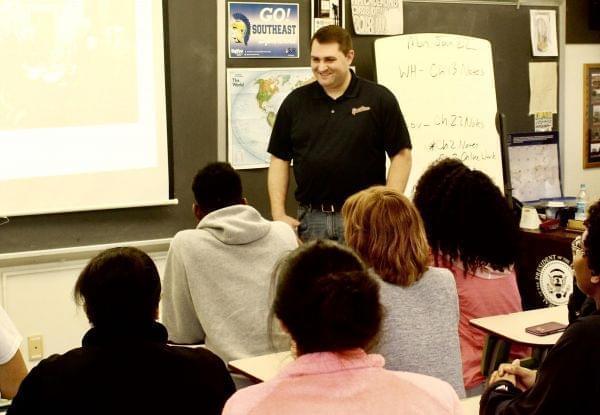State Of Trump: Teaching Current Events In 2018

Neil Calderon teaches U.S. history, government, and world history at Springfield Southeast High School. Courtesy of Neil Calderon
President Donald Trump’s administration has been in power for a year now. “State of Trump” is our series discussing what’s changed in the state, and what might be ahead.
Today we hear from high school government teacher Neil Calderon about how the Trump presidency has affected the way he teaches:
Neil Calderon: I teach government, U.S. History, and world history at Southeast High School.
Rhodes: Has it changed at all in the past year?
Calderon: In terms of the basics that we teach no, but in terms of the way I approach how to incorporate current events, it does. I think the most challenging aspect has been some of the topic matter has not been what I would say traditionally acceptable in a classroom and so finding a way to still discuss issues that come up, but not veer off into the profane has been interesting. It's been a challenge. It's not something that I've had to do in the years past, but it's been one where I think because the president likes to use Twitter and social media, I think that my students have a little bit more awareness of what's going on just because that's the world in which they tend to communicate and get their current events information from. And so I think they've brought more questions to me over the last year than in years past.
Rhodes: So did you have to say "poopy hole" in class?
Calderon: Um I try not to replace language, but instead address it without directly saying the comments saying controversial comments" or using profanity to describe other countries things like that. I mean, I think the thing that's changed overall in the 16 years that I've been teaching is that — I've told my students this — is that in the past, I would have said make sure to consume as much news and information as possible, and watch things like CNN. And now I find that I'm almost warning them not to consume too much 24-hour news, to pick their news sources much more carefully, and when they do, to use their own filter and decide what's good information and what's not.
I always start off my government classes with the idea that they are the most powerful people in the history of humankind, in that they can access information about anything that humans have known in a matter of moments. They've got devices that send signals to space and back, and they can use that to access anything and so they've got more information than anybody's ever had before. The problem is that it's all unfiltered and a lot of it comes without any context.
Rhodes: So how do you teach them to figure out what's a good source?
Calderon: Just kind of going through the process of taking, if it's a current event story, saying okay, here's how one outlet's covering it, here's how another outlet's covering it, what do you guys see is the similarities and differences, and why do you think that is? And then going through that kind of process.
Rhodes: So are you seeing a higher level of engagement? Are you seeing more enthusiasm on, you know, either way?
Calderon: I think we've seen a lot of awareness. And if awareness translates to action, I think that'll be encouraging both ways because it seems like I don't have a student that doesn't have a strong opinion one way or the other. I will say, just, I always get going with registering my students to vote in there, and I have easily 90-plus percent of them registered now.
I think I only have like five students that in my three government classes that have yet to register.
Rhodes: You are a Democratic precinct chair? Is that what you are?
Calderon: Precinct Committeeman.
Rhodes: Precinct committeeman. So you obviously have strong personal views. And as a teacher, you're supposed to be like a journalist — pretty neutral, right?
Calderon: One of the things that — I kind of take pride in this — over the 16 years that I teach, most of my students are still guessing at what political associations I have by the end of the semester, by the end of a period that we have a class. So I try to keep it as neutral as possible, present both sides. It has been more challenging and especially in this last year because there are things that, when you look at the things that President Trump does, it is outside the norm. And it's a balancing act between ... You don't want to normalize something. I mean, where if a president talks about a rally that's predominantly white supremacists and saying there's some good people there, I don't want to normalize that. But at the same time, I'm cognizant of the fact that I do have strong opinions on this and I try not to make my opinions that the ones that the students form. I want them to form their own opinions.
Links
- Trump Again Keeps U.S. In Iran Nuclear Deal—But Threatens To Get Out Later
- Trump Denies Using Vulgar Slur; Durbin Says He Said It
- Farmers Look For Trump To Deliver
- Farmers On Trump’s Speech; Caterpillar’s Overseas Tax Profits; St. Louis-Chicago Amtrak; Snowy Owls
- 3 Ways Trump Or His Allies Might Try To Disrupt The Mueller Russia Probe
- An Upset In Trump Country: Democrat Doug Jones Bests Roy Moore In Alabama

